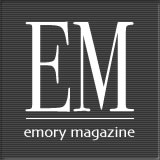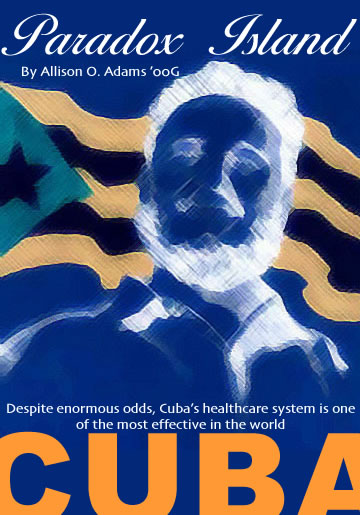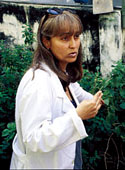|

Volume
78
Number
2

|
|
|
|
|

|
|
 ON
THE VERDANT GROUNDS of the century-old mansion
that now serves as Los Cocos AIDS Sanitorium
in Rincón, on the outskirts of Havana, a group of Rollins
School of Public Health students meets Roberto. After he
was diagnosed in 1990, Roberto, like all HIV-positive Cubans,
was quarantined in the sanitorium—a policy denounced internationally
as a system of AIDS
“concentration
camps.” ON
THE VERDANT GROUNDS of the century-old mansion
that now serves as Los Cocos AIDS Sanitorium
in Rincón, on the outskirts of Havana, a group of Rollins
School of Public Health students meets Roberto. After he
was diagnosed in 1990, Roberto, like all HIV-positive Cubans,
was quarantined in the sanitorium—a policy denounced internationally
as a system of AIDS
“concentration
camps.”
In
1994, however, President Fidel Castro’s government tacitly
acknowledged that its policies were rooted in fear and discrimination.
It redesigned the system, encouraging patients to live with
or near their families and receive care at home. The government
also formed an education and prevention program and a network
of AIDS
care centers. Even so, Roberto chose to stay in the sanitorium.
“I
feel good here,” he tells the Rollins students through
an interpreter, flashing a smile. “I have all the medical
care I need. Life would be difficult on the outside. What if
something happened to me? The first thing I do every day is
see my doctor.”
Countless
stories of paradox, irony, and success against the odds have
drawn these Emory public health students to Cuba. In spite of
reports of human rights abuses, the forty-year-old U.S. economic
embargo against Cuba, and endless shortages of food, medicines,
and other necessities after the 1989 collapse of the Soviet
Union, the island nation has managed to control the AIDS
epidemic more effectively than any other country in Latin America.
Screening virtually all of its high-risk population and the
island’s blood supply also helps control the disease, and
all infected Cubans receive care. The nation manufactures its
own HIV medications with technology pirated from U.S. patent-protected
formulas. While fewer than four thousand of Cuba’s population
of 11 million are HIV positive, its neighbor to the south, Haiti,
struggles with an epidemic among more than two hundred thousand
of its 7 million people.
What
Cuba lacks in resources it makes up for in resourcefulness.
All Cubans receive free, accessible healthcare. The system intricately
weaves public health and medicine, emphasizing community-wide
health promotion and prevention. Priority care goes to vulnerable
groups, such as children, mothers, and the elderly. Patients
are able to see specialists in the nation’s 444 multipurpose
“polyclinics.” In a nationwide network of family physician-nurse
consultorios (thirty or forty to every polyclinic), each neighborhood-based
team serves a population of six hundred to eight hundred. The
family physicians are on call twenty-four hours a day; they
spend mornings seeing patients in the clinic and afternoons
visiting them at home.
“The
family doctors must be scientists, counselors, epidemiologists,
administrators, educators, and team members,” says Claribel
Presno, president of the Cuban Society of Family Medicine, who
hosted the students during much of the trip this spring.
Statistics
bear out Cuba’s success. Last year the nation’s infant
mortality rate was 6.2 per 100,000 live births (the U.S. average
is 8 per 100,000). Deaths per 1,000 are 7, compared to 9 in
the U.S.; life expectancy is 75 (77 in the U.S. and 79 in Canada).
Infectious diseases that were leading causes of death before
the 1959 revolution (such as malaria, parasites, and tuberculosis)
have been virtually eradicated.
And
Cuba has busily grown its ranks of doctors. Before the revolution
that swept Castro to power, six thousand physicians served the
island, which had but one medical school. Today, the nation
counts twenty-one medical schools and more than thirty thousand
doctors (all of whom are required to do a three-year residency
as a family physician)–so many that Cuba routinely exports
them to work abroad.
Such
accomplishments have caught the collective eye of the international
medical and academic communities, and the Cuban system has been
praised in American medical publications such as the Journal
of Family Practice. During his historic visit to Cuba just two
months after the Rollins students, former U.S. President Jimmy
Carter also walked the grounds of the Los Cocos Sanitorium.
In his speech from the University of Havana, Carter praised
the Cuban healthcare system as “superb,” while acknowledging
that the U.S. has “stuggled unsuccessfully” to provide
universal healthcare.
Growing
numbers of American medical students are flocking to Cuba to
study the system through an Emory nursing-school-based organization
called Medical Education Cooperation with Cuba (MEDICC), which
organized the March Rollins trip as well as a visit of a group
of Emory nursing students earlier this year. Established in
1998, MEDICC works in close cooperation with Cuba’s National
School
of Public Health.

One
of the trip’s many lessons was how Cuba has met its challenges
by reconsidering medical approaches it had earlier rejected.
While the country has a small biotechnology industry, medical
and pharmaceutical necessities are in short supply. By official
sanction, “traditional” or “natural” medicine
has been integrated into mainstream, conventional healthcare
in order to fill the gap. Maria Theresa Pons (left), a family
physician in Havana, showed the students her medicinal herb
garden behind her modest, three-room consultorio, which is also
her home. She broke a sprig off a shrub and held it out to one
of the students. “This is salvia,” she said. “It’s
good for treating hepatitis.”
Tai
Chi, acupressure, homeopathy, and other unconventional methods
also come into play in treating pain and are taught in the general
medicine curriculum. Only trained physicians are permitted to
practice the techniques. They are used to complement Western
medicine, so that a patient may receive pain medications at
a clinic and then a few hours later receive acupuncture. Juventino
Acosta Mier, director of the Center for Natural and Traditional
Medicine in Matanzas, told the students, “The fight against
the pharmaceutical industry is difficult because the problem
at its center is not a health problem but an economic one.”
Mier
focuses much of his efforts on prevention, especially among
children. A class of eleven year olds recites a litany he has
taught them: eat a healthy diet, stand up straight and speak
slowly, don’t smoke, strive to balance yin and yang. Ultimately,
he hopes, his teachings will reduce hypertension, acquired diabetes,
and other preventable illnesses that are leading causes of death
in Cuba.
The
Emory students also witnessed the problems that continue to
dog Cuba’s healthcare system. While many physicians insist
that they now accept the alternative techniques because they
have seen “scientific support” for them, that support
mainly consists of clinical outcome data–not the years
of costly study and carefully controlled trials that would be
required in the United States. A visit to a medical school led
to warm and thoughtful exchanges between the American and Cuban
students, but it also revealed the host institution’s poor,
ill-equipped facilities. Presno acknowledges some distribution
problems with the fifty-two medical journals in Cuba and recognizes
that not every doctor has immediate access to the Internet,
but she says the nation’s medical information network is
gradually growing.
“Giving
away thirty thousand computers to doctors is not an economic
priority when children need cancer treatment,” she says.
“It’s not a perfect system, but we work every day
to make it better. ”
The
nation’s greatest challenge is its own economic recovery.
Facing a starving population, in the late 1990s a desperate
Cuban government legalized the U.S. dollar and accelerated investment
in tourism. Tourist hotels built during Havana’s 1950s
heyday as a gambling and resort destination for North Americans
were renovated and the glorious historic architecture of Old
Havana restored, while the rest of the city continued to crumble.
Vacationers mostly from Europe and Canada poured in, leaving
their dollars, jump-starting the economy, and creating new and
troubling social disparities. Cubans who work in the tourism
industry (as maids in the posh hotels, as taxi drivers, and
as hustlers and prostitutes) have access to U.S. dollars and
the “dollar stores” that have sprung up, offering
goods in quantity and variety unseen in the Cuban peso stores.
By contrast, those who work state jobs, including the highly
educated professionals who make up university faculty and the
medical profession, bring in only a fraction in pesos of the
amount of those earning dollars. Consequently, many professionals–among
them doctors and engineers–moonlight as cab drivers or
hotel doormen, or they abandon their state jobs altogether.
Unlike
many other healthcare-focused trips to “developing”
nations, the Rollins students didn’t go to Cuba to help
provide care. As Audrey Lenhart ’02PH, one of the students
on the trip, says, “Cuba’s doing pretty well on its
own. It’s not like they have a shortage of doctors so they
need medical students to go down there and pick up the slack.”
What
Cuba needs, says Presno, is the students’ understanding.
“Relations between the U.S. and Cuba don’t really
allow them to know the reality of what is going on. It’s
important to us that they go through a transformation while
they are here.”
That
kind of transformation is the mark of an emerging kind of student
travel, Lenhart adds. “Many short-term service trips, like
alternative spring breaks, are usually focused on some element
of service–renovating a school in Harlem, building a clinic
in Honduras. Rather than coming in as an equal and just listening
to what they have to say, the mentality is, I see you have this
problem, and I’m going to fix it. Sure, these communities
are going to have a lot of problems, but a bunch of North American
students is not the solution. It can have the effect of absolving
people of their responsibility, once they come back to the university,
because they can say they did something to help. But really
helping would be coming back and advocating for policy changes
that would create systemic, long-term solutions.”
A
better model, Lenhart says, is “to go just seeking information,
to genuinely learn about an unfamiliar situation, rather than
having some kind of preordained project. Then you can educate
people in your university around the issue. Cuba was a great
opportunity to show people how the policies of our country influence
the lives of others. Our goal was just to learn about the healthcare
system. We weren’t there to fix any problems.”
Allison
O. Adams ’00G, editor of the Academic Exchange,
accompanied a group of Rollins School of Public Health students
to Cuba in March.
|
| |
| |
|